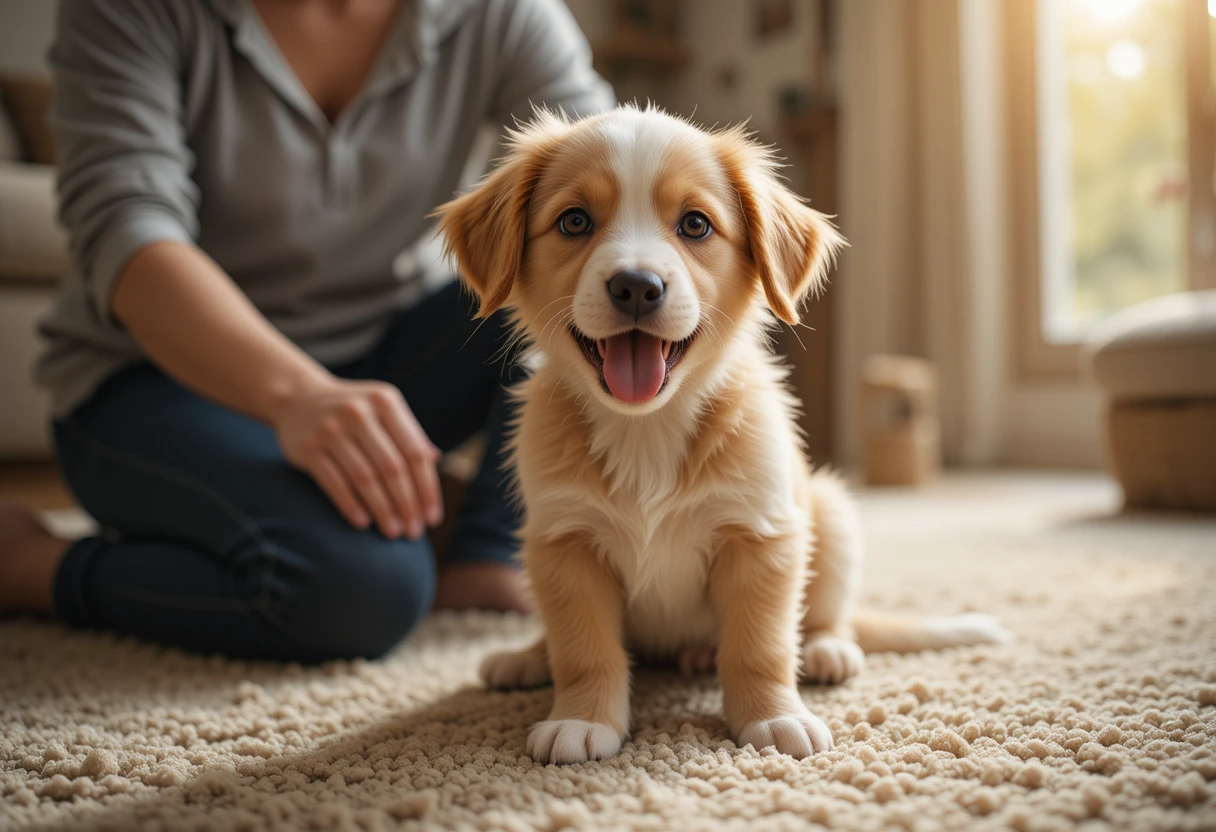Puppy excited pee is one of the most common and frustrating challenges new dog owners face. You’re enjoying a joyful reunion with your furry friend, only to discover a puddle on the floor where they were just standing.
This behavior, officially known as excitement urination, affects countless puppies and young dogs worldwide, leaving pet parents wondering if they’re doing something wrong.
The reality is that puppy excited pee is completely normal and stems from a combination of underdeveloped bladder control and overwhelming emotions. According to veterinary behaviorists, this involuntary response occurs when a puppy’s excitement levels exceed their physical ability to maintain bladder control.
Understanding this fundamental concept is the first step toward successfully managing and eventually eliminating the behavior.
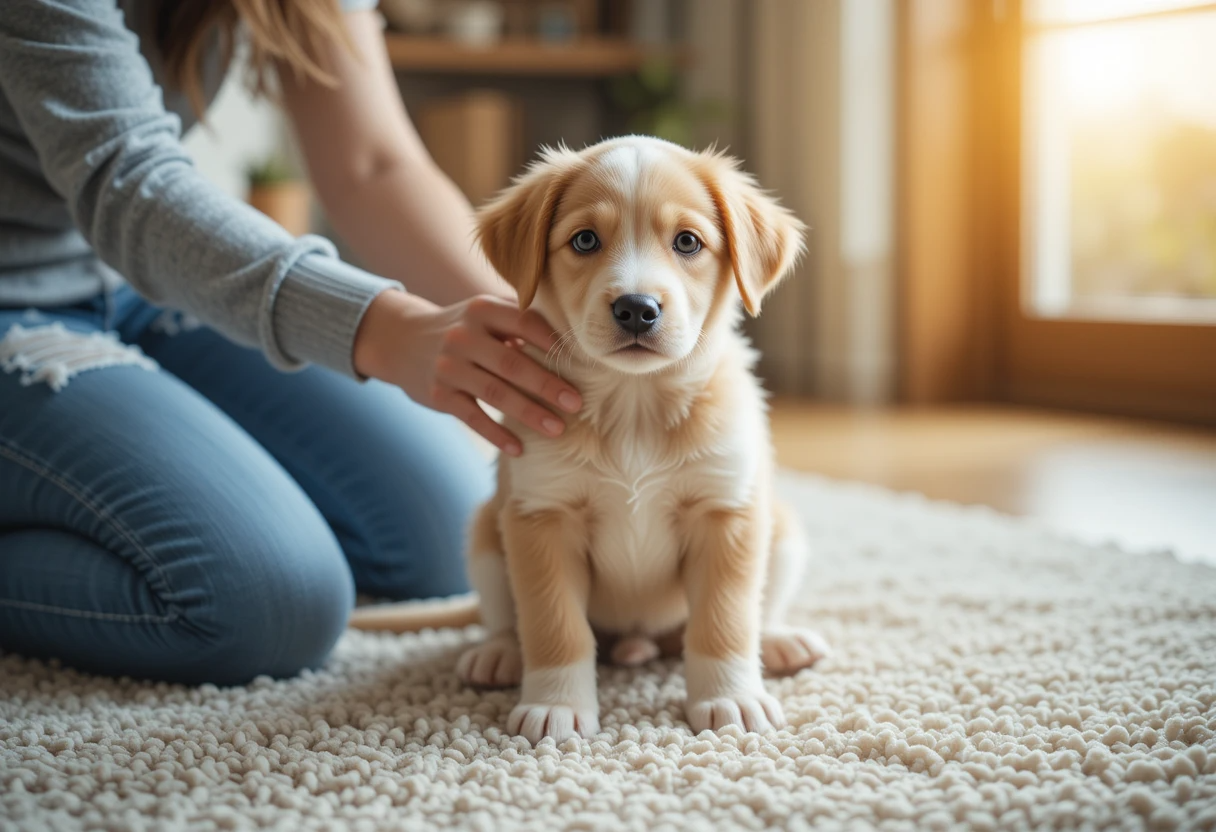
What Is Puppy Excited Pee?
Puppy excited pee, medically termed excitement urination, is an involuntary release of urine that occurs when a young dog becomes overwhelmed with positive emotions. Unlike typical house training accidents, excitement urination happens specifically during moments of high stimulation, such as greeting family members, engaging in play, or experiencing new environments.
This behavior differs significantly from deliberate marking or regular potty accidents. When experiencing excitement urination, puppies often continue moving, playing, or interacting without seeming to notice they’ve urinated. The amount of urine released is typically small, and the puppy shows no signs of deliberately squatting or lifting their leg as they would during normal elimination.
Research from the American Kennel Club indicates that excitement urination is most common in puppies under 12 months of age, particularly during the first six months of life when bladder muscles are still developing. The behavior typically resolves naturally as puppies mature and gain better emotional regulation and physical control.
The Science Behind Excitement Urination
Understanding the physiological mechanisms behind puppy excited pee helps explain why this behavior occurs and why traditional punishment-based training methods prove ineffective. When puppies experience intense excitement, their nervous system triggers a cascade of responses that can overwhelm their developing bladder control mechanisms.
Neurological Development and Bladder Control
Puppies are born with immature nervous systems, including the neural pathways responsible for bladder control. The detrusor muscle, which controls urine retention, doesn’t fully develop until puppies reach approximately 16 weeks of age. During periods of high excitement, the puppy’s immature nervous system struggles to maintain conscious control over these muscles.
Dr. Megan Keller, a veterinary behaviorist featured in PetMD, explains that excitement urination occurs because “puppies have developing bladders and less control over their urinary muscles, making accidents more likely when they are experiencing big feelings.”
Hormonal Influences
Excitement triggers the release of various hormones and neurotransmitters, including adrenaline and norepinephrine. These chemical messengers can interfere with the normal communication between the brain and bladder, leading to involuntary urination. This hormonal response is particularly pronounced in young animals whose endocrine systems are still maturing.
Breed and Size Considerations
Certain breeds may be more predisposed to excitement urination due to their temperament and physical characteristics. Small breed dogs often have proportionally smaller bladders, making them more susceptible to overflow during emotional peaks. Additionally, breeds known for their enthusiastic and energetic personalities may experience excitement urination more frequently due to their naturally heightened emotional responses.
Excitement Urination vs. Submissive Urination: Key Differences
Many pet owners confuse excitement urination with submissive urination, but these are distinct behaviors with different underlying causes and treatment approaches. Understanding these differences is crucial for implementing effective training strategies.
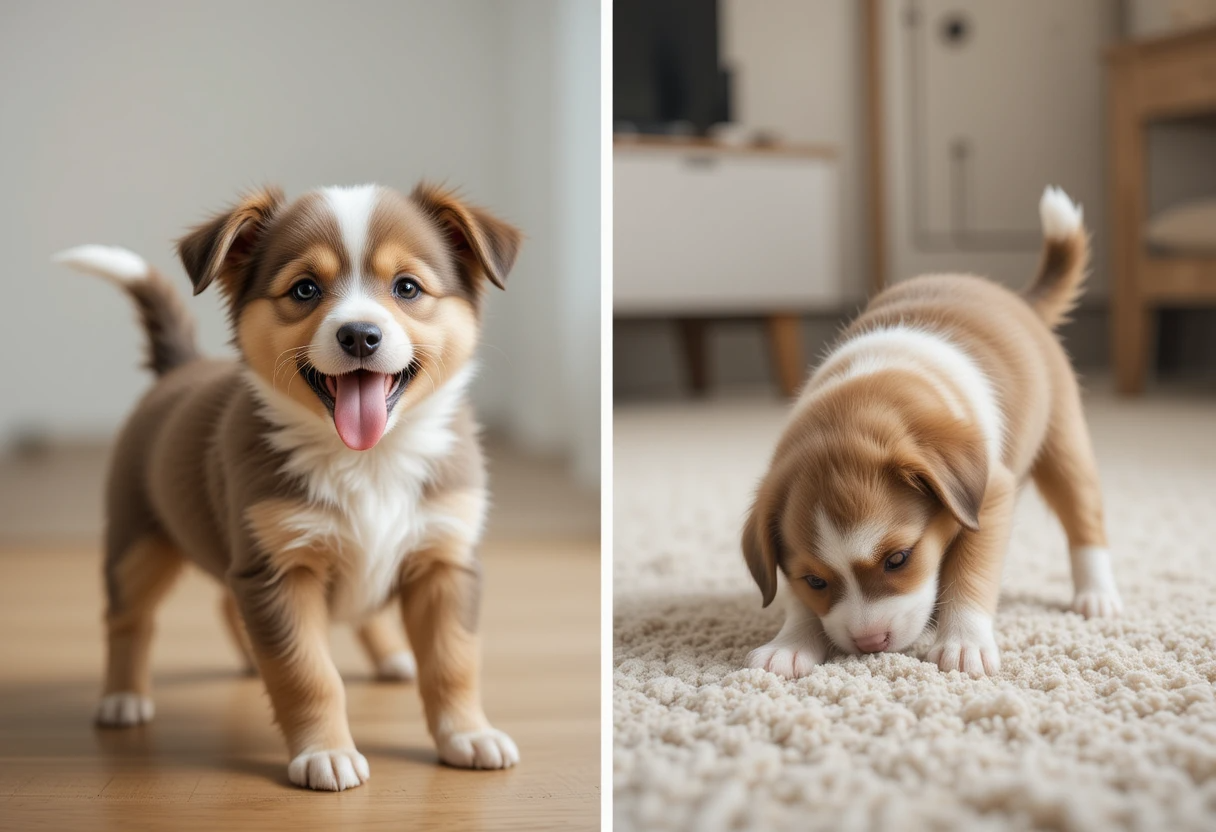
Excitement Urination Characteristics
Puppy excited pee typically occurs during positive, high-energy interactions. Key characteristics include:
- Timing: Happens during greetings, play sessions, or other stimulating activities
- Body Language: Confident, happy posture with tail wagging and alert expression
- Context: Associated with positive emotions and anticipated rewards
- Age: Most common in puppies under 12 months
- Response: Puppy remains engaged and continues the exciting activity
Submissive Urination Characteristics
In contrast, submissive urination is a fear-based response with distinctly different presentations:
- Timing: Occurs during perceived threatening situations or corrections
- Body Language: Submissive postures including lowered head, tucked tail, and avoiding eye contact
- Context: Associated with anxiety, fear, or attempts to appease perceived authority
- Age: Can persist into adulthood if not addressed
- Response: Puppy may attempt to hide or show other signs of stress
According to veterinary research from UC Davis, recognizing these differences is essential because the treatment approaches vary significantly between the two conditions.
Puppy Bladder Development Timeline
Understanding the normal progression of bladder control development helps set realistic expectations for when excitement urination should naturally resolve.
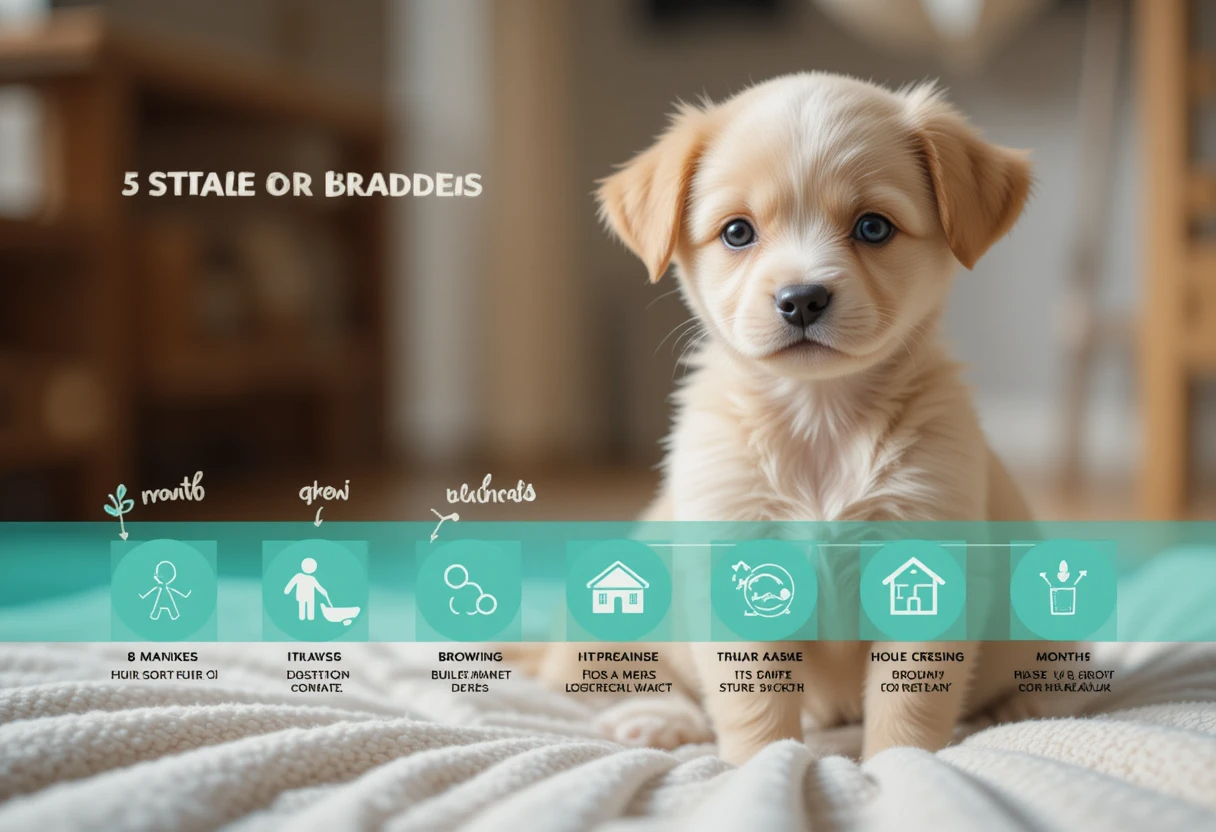
8-12 Weeks: Basic Development Phase
During this critical period, puppies begin developing basic bladder awareness but have minimal control. The general rule suggests puppies can hold their bladder for approximately one hour per month of age, plus one additional hour. However, this calculation doesn’t account for emotional states that can trigger involuntary release.
12-16 Weeks: Improved Control Phase
Most puppies begin showing improved bladder control around 12 weeks of age. The muscles responsible for urine retention become stronger, and neural pathways mature. However, excitement urination may still occur frequently during this phase, particularly during high-stimulation events.
16-24 Weeks: Maturation Phase
By 16 weeks, most puppies have developed sufficient physical bladder control for basic house training. Excitement urination typically decreases significantly during this period, though some sensitive or particularly energetic puppies may continue experiencing occasional episodes.
6+ Months: Adult-Like Control
Most dogs achieve adult-like bladder control by six months of age. Excitement urination persisting beyond this point may require professional intervention or indicate underlying medical or behavioral issues requiring veterinary evaluation.
Research from Preventive Vet indicates that “excitement urination is most common in dogs under 1 year old. As puppies mature and gain better control over their bladder and emotional regulation, excitement urination often decreases.”
Common Triggers for Puppy Excited Pee
Identifying specific triggers that cause excitement urination in your puppy is essential for developing targeted prevention strategies. While triggers vary among individual dogs, several common patterns emerge across most cases.
Greeting Behaviors
The most frequent trigger for puppy excited pee involves greeting situations, particularly when family members return home after absences. The anticipation and joy of reunion can overwhelm a puppy’s emotional regulation, leading to involuntary urination. This response is particularly pronounced when greetings involve:
- Enthusiastic verbal acknowledgment
- Physical contact like petting or picking up
- Direct eye contact and attention
- Multiple people greeting simultaneously
- Extended absence periods
Play and Interactive Activities
High-energy play sessions frequently trigger excitement urination, especially activities involving:
- Fetch and chase games
- Tug-of-war sessions
- Introduction of new toys
- Interactive training sessions with treats
- Social play with other dogs or pets
Novel Experiences and Environments
New experiences can generate sufficient excitement to trigger urination, including:
- Meeting new people or animals
- Visiting unfamiliar locations
- Exposure to new sounds, smells, or sights
- Car rides and travel experiences
- Veterinary visits or grooming appointments
Food and Treat-Related Excitement
Many puppies experience excitement urination in response to food-related stimuli:
- Meal preparation activities
- Training sessions involving high-value treats
- Special food rewards or novel flavors
- Feeding time routines and expectations
Understanding these triggers allows pet owners to modify their approach and gradually desensitize their puppies to excitement-inducing situations through controlled exposure and training.
Medical Considerations and When to Consult a Veterinarian
While excitement urination is typically a behavioral and developmental issue, certain medical conditions can contribute to or mimic this behavior. Ruling out underlying health problems is essential before implementing behavioral modification strategies.
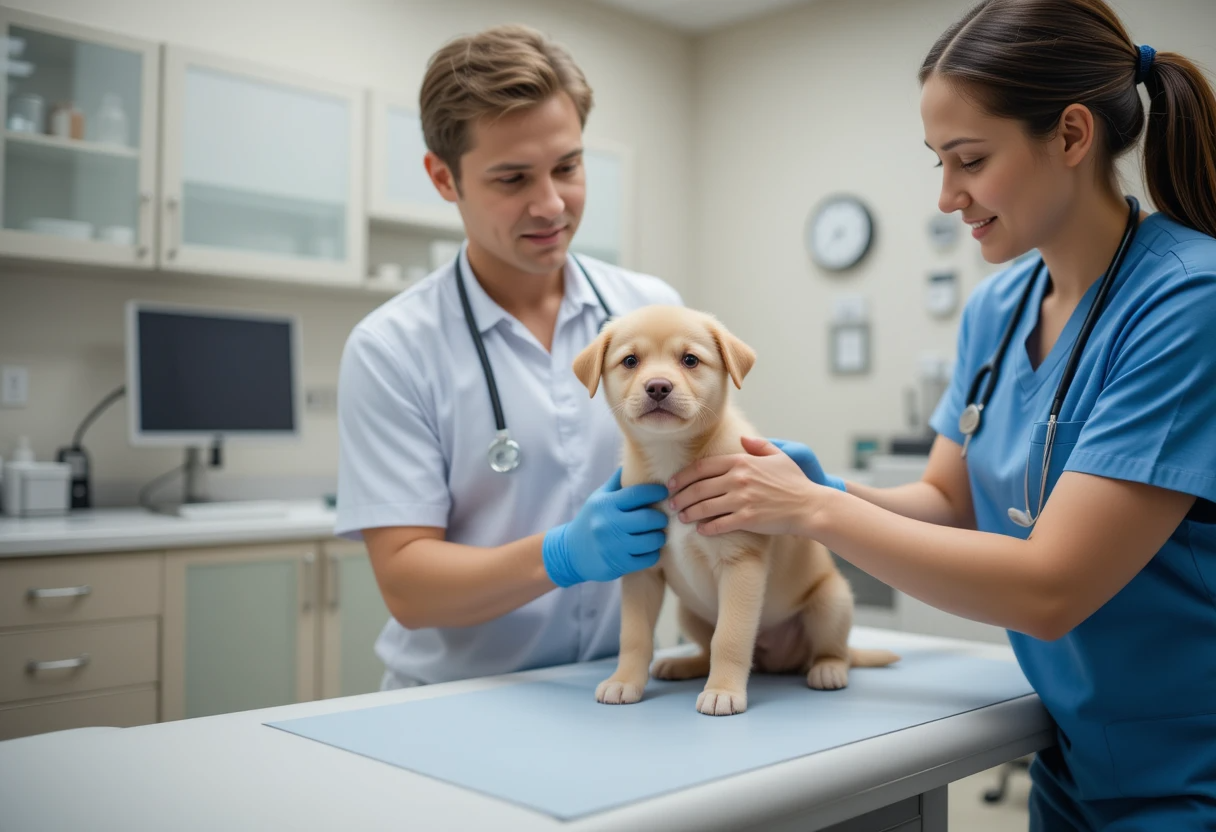
Urinary Tract Infections (UTIs)
UTIs can cause frequent urination, urgency, and loss of bladder control that may be mistaken for excitement urination. Symptoms to watch for include:
- Straining to urinate
- Blood in urine
- Frequent attempts to urinate with small volumes
- Strong odor or cloudy appearance
- Signs of discomfort during urination
Congenital Abnormalities
Some puppies are born with structural abnormalities affecting bladder control, such as:
- Ectopic ureters (ureters connecting in abnormal locations)
- Bladder malformations
- Spinal cord defects affecting nerve function
- Hormonal deficiencies affecting muscle development
Parasites and Gastrointestinal Issues
Internal parasites can cause digestive upset that increases overall anxiety and may contribute to elimination problems. Additionally, gastrointestinal inflammation can affect nearby urinary structures.
When to Seek Veterinary Care
Contact your veterinarian if your puppy exhibits:
- Persistence of excitement urination beyond 8 months of age
- Sudden onset of urination problems in a previously house-trained dog
- Signs of pain or discomfort during urination
- Changes in urine color, odor, or consistency
- Excessive water consumption or frequent urination
- Other behavioral changes accompanying urination issues
Early veterinary evaluation helps ensure proper diagnosis and prevents minor issues from developing into more serious problems.
Effective Training Strategies for Managing Puppy Excited Pee
Successfully managing excitement urination requires a multi-faceted approach combining environmental management, behavioral modification, and consistent training protocols. The following evidence-based strategies have proven effective for reducing and eventually eliminating this behavior.
Calm Greeting Protocols
Implementing structured greeting routines significantly reduces excitement urination episodes. Effective protocols include:
Step 1: Ignore Initial Excitement
- Avoid eye contact, verbal acknowledgment, or physical interaction upon arrival
- Allow the puppy to calm down naturally without stimulation
- Wait for relaxed body language before providing attention
Step 2: Low-Key Interactions
- Use quiet, calm vocal tones when first acknowledging the puppy
- Avoid sudden movements or energetic gestures
- Keep initial interactions brief and controlled
Step 3: Redirect Energy
- Toss treats away from yourself to redirect the puppy’s focus
- Encourage calm behaviors like sitting or lying down
- Reward composed behavior with gentle praise
Research from Best Friends Animal Society confirms that “the best strategy is just to ignore the dog at first. Act calmly, don’t talk or move in an excited manner, don’t pet the dog, and if necessary don’t make eye contact.”
Environmental Management Techniques
Strategic environmental modifications can prevent accidents and reduce anxiety associated with cleanup:
Outdoor Greetings
- Conduct initial greetings outside whenever possible
- Utilize fenced yards or controlled outdoor spaces
- Encourage elimination before entering the house
Surface Protection
- Use washable rugs or protective coverings in high-risk areas
- Consider temporary belly bands or diapers during training
- Maintain easy-clean surfaces in frequently used spaces
Controlled Access
- Limit access to carpeted or difficult-to-clean areas during training
- Use baby gates to manage movement patterns
- Create designated greeting areas with appropriate flooring
Impulse Control Training
Teaching puppies to manage their emotional responses through structured training exercises proves highly effective for reducing excitement urination:
Wait Commands
- Train puppies to wait before eating, entering/exiting, or receiving attention
- Practice holding positions despite distractions
- Gradually increase duration and difficulty
Settle Training
- Teach a specific “settle” or “place” command for calm behavior
- Practice during low-excitement periods initially
- Gradually introduce mild distractions while maintaining the settle position
Focus Exercises
- Train attention and focus commands to redirect energy
- Use high-value treats to maintain engagement during training
- Practice in various environments to generalize the behavior
Confidence Building Activities
For puppies showing signs of both excitement and submissive urination, confidence-building exercises provide significant benefits:
Positive Socialization
- Expose puppies to various people, animals, and environments gradually
- Ensure all experiences remain positive and non-threatening
- Allow puppies to approach new situations at their own pace
Success-Based Training
- Design training exercises where puppies can easily succeed
- Use positive reinforcement exclusively
- Avoid corrections or punishment that may increase anxiety
Independent Problem-Solving
- Provide puzzle toys and mental enrichment activities
- Encourage exploration and investigation of new objects
- Reward brave and confident behaviors consistently
👉Check out our guide on DIY Cat Tree Plans For Small Spaces: Smart Ideas to Save Space & Keep Cats Happy
Lifestyle Modifications to Reduce Excitement Urination
Beyond specific training protocols, several lifestyle adjustments can significantly impact the frequency and severity of excitement urination episodes.
Exercise and Mental Stimulation
Adequate physical exercise and mental enrichment help regulate a puppy’s overall energy levels and emotional state:
Daily Exercise Requirements
- Provide age-appropriate physical activity based on breed and size
- Include both structured exercise and free play opportunities
- Schedule exercise sessions before high-excitement events when possible
Mental Enrichment Activities
- Incorporate puzzle feeders and interactive toys into daily routines
- Practice training sessions using positive reinforcement methods
- Rotate toys and activities to maintain novelty and engagement
Structured Routine
- Establish consistent daily schedules for feeding, exercise, and rest
- Provide predictable patterns that reduce overall anxiety
- Include designated calm periods throughout the day
Diet and Hydration Management
While maintaining proper nutrition and hydration, strategic timing can help minimize accidents:
Feeding Schedules
- Implement consistent meal timing to predict elimination needs
- Avoid feeding immediately before high-excitement events
- Monitor treats and snacks that may increase water consumption
Water Management
- Ensure constant access to fresh water for proper health
- Monitor consumption patterns to identify potential medical issues
- Consider timing of water access relative to training sessions
Sleep and Rest Patterns
Adequate rest is crucial for emotional regulation and physical development:
Sleep Requirements
- Puppies need 18-20 hours of sleep per day for proper development
- Provide quiet, comfortable sleeping areas away from high-traffic zones
- Establish consistent bedtime routines to promote quality rest
Calm Periods
- Schedule regular quiet time throughout the day
- Encourage relaxation through gentle massage or calm activities
- Avoid overstimulation that can lead to emotional overwhelm
Learn the steps to start your career with our guide on How to Become a Psychiatric Service Dog Trainer in 2025.
Professional Training Resources and Support
While many cases of excitement urination resolve with consistent home training, some situations benefit from professional intervention and guidance.
When to Seek Professional Help
Consider consulting a certified dog trainer or veterinary behaviorist if:
- Excitement urination persists beyond 8-10 months of age
- The behavior worsens despite consistent training efforts
- Multiple behavioral issues occur simultaneously
- Family members struggle to implement consistent protocols
- The puppy shows signs of anxiety or fear-based behaviors
Choosing Qualified Professionals
Look for professionals with appropriate credentials and experience:
Certification Programs
- Certification Council for Professional Dog Trainers (CCPDT)
- International Association of Canine Professionals (IACP)
- Association of Professional Dog Trainers (APDT)
Specialization Areas
- Puppy development and socialization
- Behavioral modification techniques
- Positive reinforcement training methods
- Experience with elimination issues
Training Philosophy
- Force-free and positive reinforcement approaches
- Science-based training methods
- Understanding of canine development and behavior
- Commitment to ongoing education and professional development
Support Groups and Resources
Many communities offer support resources for puppy owners:
Puppy Training Classes
- Socialization opportunities with other puppies
- Professional guidance in group settings
- Support from other pet owners facing similar challenges
Online Communities
- Breed-specific forums and social media groups
- Professional trainer-moderated discussion groups
- Educational webinars and virtual training sessions
Educational Materials
- Books by certified canine behaviorists
- Reputable websites and training resources
- Continuing education opportunities for pet owners
Advanced Management Techniques for Persistent Cases
For puppies whose excitement urination persists beyond typical developmental timelines, advanced management strategies may prove necessary to achieve complete resolution.
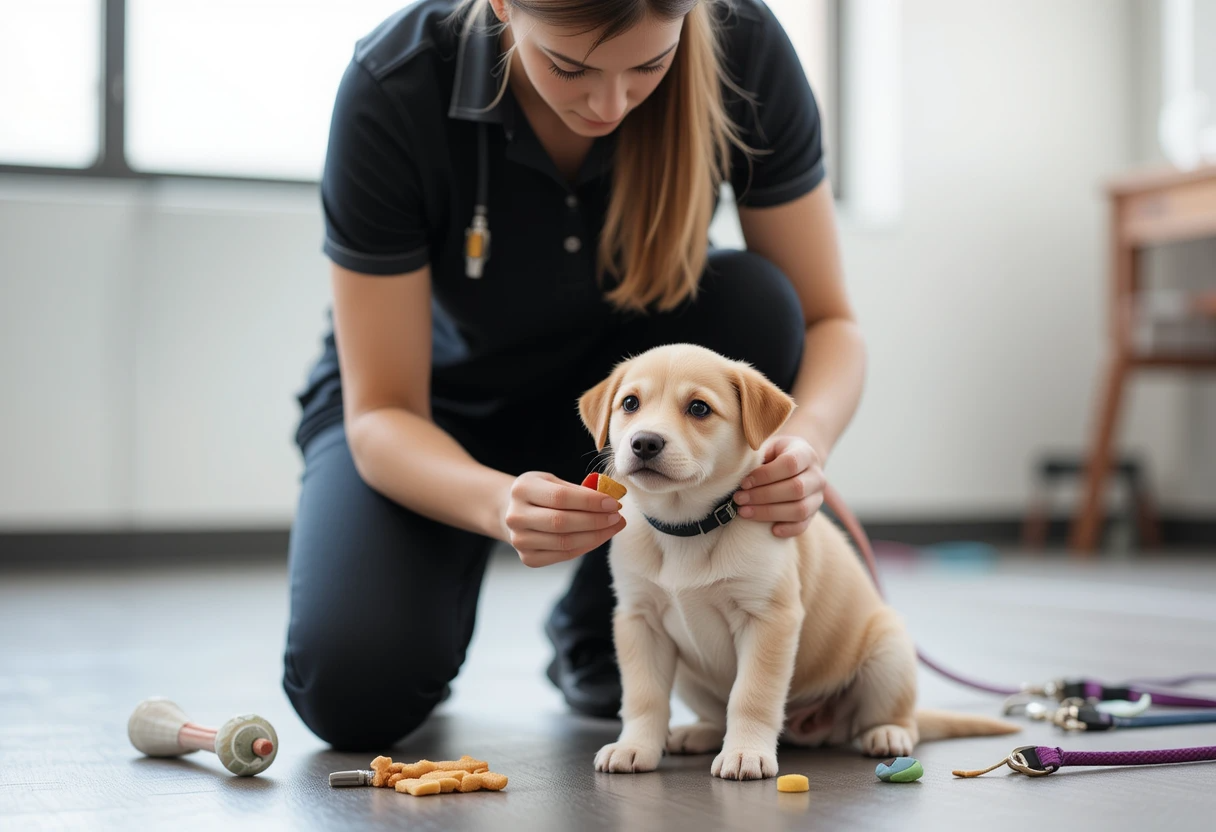
Desensitization and Counter-Conditioning Protocols
Systematic desensitization helps puppies learn to remain calm during previously exciting situations:
Graduated Exposure Plans
- Identify specific triggers that cause excitement urination
- Create a hierarchy of trigger intensity from mild to severe
- Practice exposure to low-intensity triggers while maintaining calm behavior
- Gradually increase trigger intensity as the puppy demonstrates success
Counter-Conditioning Techniques
- Pair previously exciting stimuli with relaxation cues
- Use high-value treats to create positive associations with calm behavior
- Practice calm responses in controlled training environments
- Generalize trained behaviors to real-world situations
Medication Considerations
In severe cases where behavioral modification alone proves insufficient, veterinary consultation regarding medication options may be beneficial:
Anti-Anxiety Medications
- Short-term use during intensive training periods
- Support for puppies with severe anxiety components
- Always used in conjunction with behavioral modification
- Requires ongoing veterinary monitoring and assessment
Hormonal Treatments
- For cases involving hormonal imbalances affecting bladder control
- Particularly relevant for female puppies with estrogen-related issues
- Requires comprehensive veterinary evaluation and diagnosis
Alternative Therapy Approaches
Some pet owners find success with complementary therapy approaches:
Aromatherapy and Calming Aids
- Dog-safe essential oils for relaxation
- Pressure wraps and calming clothing
- White noise machines for environmental management
Massage and Touch Therapy
- Gentle massage techniques to promote relaxation
- TTouch and other specialized canine massage methods
- Regular handling exercises to reduce overall sensitivity
Long-Term Prevention and Maintenance
Successfully managing excitement urination requires ongoing commitment to maintaining training protocols and preventing regression.
Consistency Across Family Members
All household members must implement identical protocols to prevent confusion and maintain progress:
Family Training Sessions
- Educate all family members on proper greeting techniques
- Practice consistent commands and responses
- Establish clear rules for interactions with the puppy
Guest Preparation
- Provide guests with specific instructions for interacting with your puppy
- Consider providing written guidelines for frequent visitors
- Practice greeting scenarios with cooperative friends and family
Monitoring and Adjustment
Regular assessment of progress helps identify areas needing adjustment:
Behavior Tracking
- Maintain records of excitement urination episodes
- Note specific triggers and circumstances
- Track improvement over time to identify patterns
Protocol Refinement
- Adjust training intensity based on progress
- Modify environmental management as needed
- Adapt techniques based on your puppy’s individual responses
Preparing for Life Transitions
Major life changes can trigger regression in previously resolved excitement urination:
Moving to New Homes
- Gradually introduce puppies to new environments
- Maintain consistent routines during transitions
- Prepare guests in new communities with appropriate protocols
Adding New Family Members
- Slowly introduce new pets or family members
- Maintain individual attention for your puppy during adjustments
- Monitor for regression and adjust training accordingly
If you have multiple dogs at home and want to keep the air clean and fresh, check out our detailed guide on the Best Air Purifier for Homes with Multiple Dogs in 2025 . It covers top models that effectively reduce pet dander, odors, and allergens to create a healthier living space for you and your furry friends.
FAQs
Yes, most puppies naturally outgrow excitement peeing as they mature. According to veterinary experts, excitement urination typically resolves by 6-8 months of age as puppies develop better bladder control and emotional regulation. However, the timeline can vary based on individual development, breed characteristics, and training consistency. Smaller breeds may take slightly longer due to their proportionally smaller bladders, while some energetic breeds might need additional training support beyond the typical timeframe. Do puppies grow out of excitement peeing?
What’s the difference between excited peeing and submissive urination?
Excited peeing occurs during positive, high-energy situations when puppies feel happy and stimulated, such as during greetings or play sessions. The puppy maintains confident body language with wagging tail and alert posture. Submissive urination, conversely, happens when puppies feel threatened, anxious, or overwhelmed, accompanied by submissive body language like lowered head, tucked tail, and avoiding eye contact. Understanding this distinction is crucial because treatment approaches differ significantly between the two conditions.
How can I stop my puppy from peeing when visitors arrive?
To prevent excitement urination during visitor arrivals, implement calm greeting protocols by having guests ignore your puppy initially until they settle down. Keep interactions low-key with quiet voices and minimal physical contact. Consider conducting greetings outdoors when possible, and redirect your puppy’s energy by tossing treats away from visitors. Train a “place” or “settle” command that you can use when guests arrive, rewarding calm behavior consistently.
Is excitement urination a sign of poor house training?
No, excitement urination is completely separate from house training issues. Puppies experiencing excitement urination typically understand where they should eliminate and have good house training habits otherwise. This behavior is involuntary and occurs specifically during emotionally charged moments when their excitement overwhelms their physical ability to maintain bladder control. Continue with regular house training while addressing the excitement component through behavior modification techniques.
Should I punish my puppy for excited peeing?
Never punish a puppy for excitement urination, as this is an involuntary behavior they cannot control. Punishment can worsen the problem by adding anxiety and fear components, potentially converting excitement urination into submissive urination. Instead, focus on management strategies like calm greetings, environmental modifications, and positive reinforcement training. Clean accidents thoroughly with enzymatic cleaners and redirect your puppy’s energy toward appropriate behaviors.
Conclusion: Success Through Understanding and Patience
Puppy excited pee represents a normal developmental phase that requires patience, understanding, and consistent management rather than punishment or frustration. By recognizing that excitement urination stems from immature bladder control combined with overwhelming positive emotions, pet owners can implement effective strategies that address the root causes while supporting their puppy’s healthy development.
The key to success lies in combining multiple approaches: calm greeting protocols, environmental management, impulse control training, and lifestyle modifications that promote emotional regulation. Most importantly, remember that this behavior is temporary and typically resolves naturally as puppies mature, provided they receive appropriate support and training.
Success stories from countless pet owners demonstrate that with dedication to proper training techniques and understanding of canine development, excitement urination can be effectively managed and eventually eliminated entirely. The bond between pet and owner often strengthens through this process as communication improves and mutual understanding develops.
For puppies whose excitement urination persists beyond normal developmental timelines or shows signs of anxiety-related components, professional support from certified trainers or veterinary behaviorists can provide valuable guidance and specialized intervention strategies.
Remember that every puppy develops at their own pace, and what works for one may require modification for another. The most successful approach combines scientific understanding with patient, consistent application of proven training methods, always prioritizing the puppy’s emotional well-being and physical health throughout the process.
If you’re looking for soft meals your older feline can enjoy, check out our guide on the Best Wet Food for Senior Cats with No Teeth: Top Picks & Tips.
